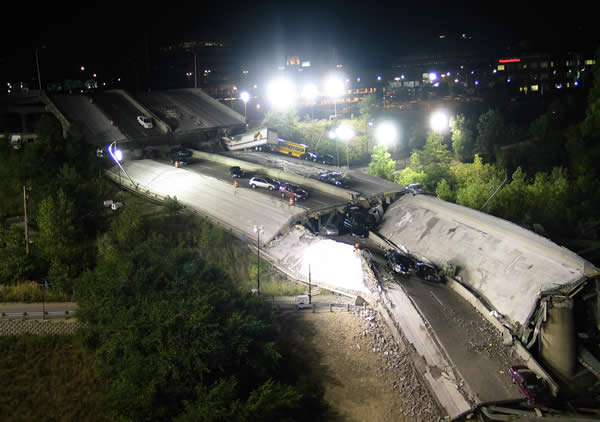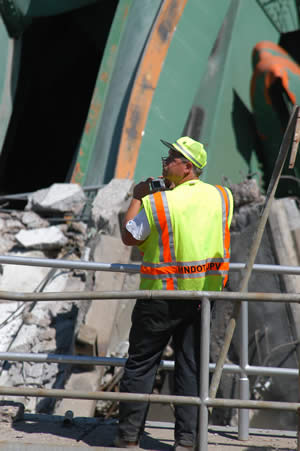By Craig Wilkins

Illuminated by powerful lights, the disaster scene glows in the early morning darkness of Aug. 2, just hours after the I-35W bridge over the Mississippi River in Minneapolis collapsed and sent the structure and dozens of vehicles into the river. Photo by Kent Barnard
|
Resources to support recovery from the Aug.1 collapse of the Interstate 35W bridge in Minneapolis poured into the state while efforts to replace the fallen span and ensure the safety of others continue to solidify.
“The focus of the multi-agency effort is on recovery until all the missing are accounted for,” said Bob McFarlin, assistant to the commissioner for policy and public affairs. “This is a slow, deliberate and respectful process.”
Navy dive crews began working 2 a.m. on Aug. 6, joining the recovery efforts started by state and local agencies immediately after the collapse. In addition, the FBI deployed a submersible search vehicle equipped with cameras, high-intensity lights and a grab arm in the effort as well.
Mn/DOT has contracted with Carl Bolander and Sons of St. Paul to begin debris removal as soon as Hennepin County concludes its recovery operation for those who perished in the collapse.
“Things are going about as well as they can,” said Terry Zoller, Metro District construction engineer who leads the recovery effort. “Right now we’re on hold until we get the go-ahead from Hennepin County.”
Zoller said that once debris removal begins, it will be a slow, tedious process.
“We’ll be taking out pieces very methodically, not just tossing them on a barge,” he said.
Experts in the field of bridge and other structural failures will use the recovered pieces and other data in their analyses to identify the causes of the I-35W bridge collapse.

Bridge inspectors comb the superstructure of the John Blatnik Bridge in Duluth as part of the response to inspect all state bridges which have a similar design to the fallen I-35W bridge in Minneapolis. Photo by John Bray
|
Statewide bridge inspections
Mn/DOT bridge inspection crews have been working intensely since the bridge fell to ensure the safety of other steel deck truss bridges. The department’s effort comes in response to a directive from U.S. Secretary of Transportation Mary E. Peters that all states inspect similar bridges for possible weaknesses or other problems.
The other steel deck truss bridges in Minnesota that have been inspected in the last few days are Hwy 23 over the Mississippi River in St. Cloud, Hwy 123 over the Kettle River in Sandstone, Hwy 243 over the St. Croix River to Osceola, Wisc., the First Street South bridge in Sauk Rapids and the Gooseberry Falls Bridge on Hwy 61 north of Duluth.
Metro District inspector hurt during bridge collapse
Bob Rucker, a pavement inspector assigned to the Mendota Heights resident office, suffered multiple injuries from the bridge collapse.
Eric Embacher, resident engineer at Mendota Heights, said Rucker was checking the rehabilitation work being performed mid-span on the bridge.
Rucker fell several feet, eventually landing on a fallen deck section with the wheels of a semitrailer dangling above him.
Rucker suffered several broken ribs, bruises and contusions. He is now recovering at home following his release from the hospital on Aug. 7.
Fellow inspectors Rae Tressler and Harvey Unruh were at the bridge site but clear of the structure when it failed, Embacher said.
Measures under way to keep traffic moving following the bridge’s fall

Doug Theis, a Metro District safety administrator, briefs Mike Garza (at left) and Deb Ledvina (at right) both of Human Resources and Administration, and Gary Ruud, Office of Communications, on rescue and recovery operations at the bridge site. Photo by David Gonzalez
|
Mn/DOT is working closely with several other agencies to relieve traffic congestion caused by the bridge collapse.
Amr Jabr, Metro District traffic engineer, said planned measures (known as traffic restoration projects) include adding lane capacity to sections of Hwy 100 and I-94. The measures also include adding capacity to the following ramps: northbound Hwy 100 to eastbound I-694, northbound Hwy 280 to eastbound I-35W EB, and eastbound I-94 to northbound Hwy 280.
Jabr said Metro District and other Mn/DOT staff continue to plan traffic changes with the cities of Minneapolis and St. Paul, the State Patrol, Hennepin County, Metro Transit and the University of Minnesota.
Metro Transit, he said, has added more buses and turned shoulders on I-694 into bus-only lanes between I-35 and the East River Road . It may also increase its number of park-and-ride facilities.
Traffic on the major Twin Cities routes has been lighter than expected so far, Jabr said, but demand started to increase with the start of the work week on Aug. 6.
“We’ve done better than we expected managing traffic until now,” Jabr said, “but traffic patterns are not settled because people are still exploring new routes for commuting and other travel.”
For traffic and detour information, visit www.511mn.org and www.mndot.gov.

Gust Scharffbillig, a Metro District maintenance supervisor, photographs an aspect of the collapsed I-35W bridge in Minneapolis. Photo by David Gonzalez |
State Emergency Operations Center activated after the bridge collapse
Mn/DOT joined other state departments, volunteer agencies and the Minnesota National Guard to start operation of the state Emergency Operations Center in St. Paul within hours of the bridge collapse.
The SEOC facilitated inter-agency communications and operations at the St. Paul location until a joint public information center near the bridge site was established Aug. 6 at the University of Minnesota’s West Bank campus in Minneapolis. Mn/DOT and other agencies provide communications people to staff the JIC.
An incident command center was established on the 10th Avenue bridge; the Minneapolis Fire Department directs its operation.
There are about 75 fire fighting and 75 law enforcement units on scene, including collapsed structure rescue and dive teams. The State Patrol manages law enforcement resources and activities from outside the city of Minneapolis.
Metro District names staff to manage I-35W replacement efforts
Khani Sahebjam, Metro District engineer, announced staff reassignments to facilitate building a replacement for the I-35W bridge in Minneapolis.
Jon Chiglo, Metro District, was appointed as the project manager for the I-35W bridge project. He previously served as manager of the Hwy 212 rebuilding project.
His staff will include Terry Ward, ROC 52 project manager/Hwy 52 Oronoco construction manager; Kevin Western, state bridge design engineer; Kevin Anderson, a Metro District administrative engineer, and many others. The team will be temporarily located at the Metro District headquarters in Roseville until a permanent office location is determined.
Chiglo can be reached at 651/775-8778.
Charles Cadenhead was named as acting Hwy 212 project manager and will assume Chiglo’s responsibilities until further notice.

Watercraft pass through the shadow of the 10th Avenue bridge during the initial recovery phase that followed the I-35W bridge collapse. Photo by David Gonzalez |
|



